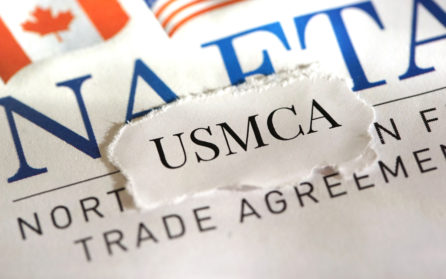Blog
When it Comes to USMCA Benefits, not all Products are Created Equally

Although it’s generally understood that the North American Free Trade Agreement (USMCA) eliminated tariffs on eligible products traveling between the United States, Canada, and Mexico, less understood is that not all products qualify for duty free treatment.
Determining which goods qualify for USMCA benefits, and knowing how to initiate the process for claiming those benefits can be a highly confusing process. A new white paper from Purolator International, “Understanding USMCA and its Implications for U.S./Canada Trade,” offers a detailed overview for businesses that ship regularly to Canada, and want to ensure they take advantage of all available trade benefits.
As the paper makes clear, “origination” is the key factor in whether or not a product is eligible for duty free treatment. USMCA provided for the elimination of all tariffs and most non-trade barriers on goods produced and traded within North America. But understanding if a product qualifies, or what percentage of a finished product’s component parts can be of non-USMCA origin, can be an exceedingly intricate process. Failure to assign the proper tariff classification code – based on the Harmonized Tariff Code of the United States — can result in having to pay higher duty rates than necessary, or in missing out on trade agreement benefits.
To help clarify eligibility, USMCA established “rules of origin,” that drill down into a product’s component parts. For every product, there is a rule of origin, but finding the appropriate rule — and applying the correct interpretation — can sometimes be challenging. For one thing, the rules are reviewed on a continual basis, so product eligibility may change over a period of time. Consider the following example from the U.S. Department of Commerce website:
A batch of cupcakes have been baked in the United States, but are comprised entirely of imported ingredients.
Cupcakes: Harmonized System Code: 1905.90
(In this example, the first two digits (19) are called the Chapter; the first four digits (1905) are called the Heading; and the first six digits (1905.90) are called the Subheading)
The first step to determine eligibility would be to look up the USMCA rule of origin with regard to Chapter 19. In this example, the Rule states that a product is eligible for USMCA preferential treatment if component parts are not also found in Chapter 19. For the sake of our cupcakes:
Flour – Chapter 1101
Sugar – Chapter 2102
Cocoa – Chapter 1806
Baking Soda – Chapter 2836
Eggs: Chapter 0407
Therefore, because none of the ingredients fall under Chapter 19, the cupcakes are eligible for USMCA benefits.
USMCA recently marked the 20th anniversary of its implementation. The agreement has its supporters and critics, but it is undeniable that trade among the U.S., Canada and Mexico has increased dramatically during its period of implementation. As the agreement begins its third decade, businesses would be smart to avail themselves fully of its benefits and opportunities. Click here to download a complimentary copy of the new white paper.